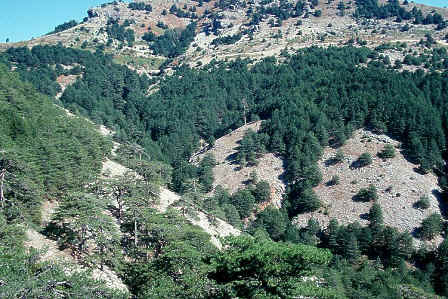______________________________________________________________________
ISLAND DESCRIPTION
 Thásos is a roughly
circular island about 30 kms in diameter and with an area of c. 300 sq.kms. The
island is dominated by the mountain ranges of Ypsario (1204 metres) and Profitis
Ilias (1100 metres) and the majority of the centre is covered by commercially
managed pine forest. Towns and villages are mainly confined to the narrow,
low-lying, coastal fringe, where olive groves are a prominent feature of the
landscape. The island’s main road connects these settlements and its 93 kms
provide an excellent tour of the scenery and features of interest.
Thásos is a roughly
circular island about 30 kms in diameter and with an area of c. 300 sq.kms. The
island is dominated by the mountain ranges of Ypsario (1204 metres) and Profitis
Ilias (1100 metres) and the majority of the centre is covered by commercially
managed pine forest. Towns and villages are mainly confined to the narrow,
low-lying, coastal fringe, where olive groves are a prominent feature of the
landscape. The island’s main road connects these settlements and its 93 kms
provide an excellent tour of the scenery and features of interest.
Access inland is via the few minor roads
that service the handful of villages in the mountains. Beyond these, the island
is criss-crossed by forest tracks that allow access to the mountain tops. These
tracks are bulldozed into the mountainsides and of variable quality. Sections
are occasionally washed away during winter floods so it can be difficult to
predict the best route but most are passable with care and a suitable vehicle.
The effort is well worth it as some of the best scenery and habitat is found on
the highest ground, where limestone pavement and ancient pine forest meet.
Characteristically, Thásos has a
fascinating history and striking ruins of past civilisations are dotted
throughout the lowlands. Even the mountain villages are a reflection of a
turbulent past when people retreated from coastal settlements to the relative
safety of the interior. Thásos has ‘changed hands’ several times and only
returned to government by Greece in 1913 after liberation from Turkey by the
Greek Navy. During the Second World War the island was occupied between April
1941 and October 1944 by Bulgaria (resulting in several important biological
surveys by Bulgarian ecologists). Today, the 18,000 residents are employed mainly by the industries of
agriculture, forestry, fishing, marble and tourism. The island has traditionally
been popular with Greek tourists but over the past twenty years or so there has
been an increasing international tourist industry. This has seen expansion of
tourist facilities in some of the larger towns but, with the exception of
Limenaria Bay on the south coast and Golden Beach on the east coast, the
landscape is still largely unspoilt. Thásos is famed for its marble, honey and
walnut jam and, because of its verdant forests, is known as ‘the emerald isle’.




 Thásos is a roughly
circular island about 30 kms in diameter and with an area of c. 300 sq.kms. The
island is dominated by the mountain ranges of Ypsario (1204 metres) and Profitis
Ilias (1100 metres) and the majority of the centre is covered by commercially
managed pine forest. Towns and villages are mainly confined to the narrow,
low-lying, coastal fringe, where olive groves are a prominent feature of the
landscape. The island’s main road connects these settlements and its 93 kms
provide an excellent tour of the scenery and features of interest.
Thásos is a roughly
circular island about 30 kms in diameter and with an area of c. 300 sq.kms. The
island is dominated by the mountain ranges of Ypsario (1204 metres) and Profitis
Ilias (1100 metres) and the majority of the centre is covered by commercially
managed pine forest. Towns and villages are mainly confined to the narrow,
low-lying, coastal fringe, where olive groves are a prominent feature of the
landscape. The island’s main road connects these settlements and its 93 kms
provide an excellent tour of the scenery and features of interest.